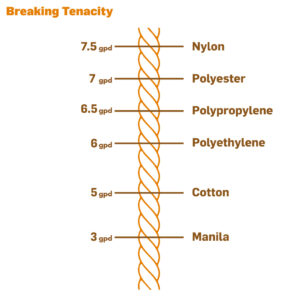Free Shipping on orders $99+

For all twine, cables, cordage, and rope, fibers are the building blocks. Consequently, in order to best understand rope and the rope that you need for your business, you must first understand the different kinds of fibers and their varying properties. When it comes to industrial fibers, there are both synthetic and natural variations used for cordage.
Here’s a cheat sheet to help you understand the most common synthetic and natural, industrial fibers:
First, it’s important to understand what makes a fiber industrial. A fiber is considered industrial grade when it has a “high breaking tenacity.”

What does this mean? Breaking tenacity is the breaking strength of a fiber as expressed via linear density. (Basically, at what level of force will the fiber break.) This is measured by gpd, or grams per denier. A denier is a unit of measure for the linear mass density of fibers. Industrial grade fibers will have a breaking tenacity between 5.0 and 15.0 gpd.
Commonly known as nylon, polyamide was the first synthetic fiber to be used in cordage.
It is composed of linear macromolecules with recurring amide linkages in the chain. 85% of these amide linkages are joined to aliphatic or cycloaliphatic units.
There are two types of nylon that are commonly used in rope-making: nylon 6 and nylon 6.6. In terms of breaking tenacity, moisture regain, and sunlight resistance, both types of nylon perform comparably; they have a breaking tenacity of 7.5 gpd, a moisture of 4-6%, and a good sunlight resistance. However, these two type of nylon differ in melting temperature; nylon 6 melts at 218℃, while nylon 6.6 melts at 258℃.
A polyolefin consists of a long-chain synthetic polymer composed of at least 85%, by weight, of ethene, propane, or other olefin units.
Two common types of polyolefins are polypropylene and polyethylene.
Polypropylene is formed by melts spinning and drawing polymers or copolymers of propylene. It has a breaking tenacity of 6.5 gpd and a melting point of 165℃.
Polyethylene, on the other hand, is slightly weaker. It is composed of polymers of ethylene and has a breaking tenacity of 6 gpd and a melting point of 140 ℃. Both polypropylene and polyethylene are only fairly resistant to sunlight exposure and have a moisture regain of 0%.

Polyester is made from linear polymer polyethylene terephthalate. It includes polymers composed of linear macromolecules, 85% of which are, by mass, of an ester of a diol and terephthalic acid.
Polyester has a breaking tenacity of 7 gpd and a moisture regain of 0%. It has a high melting point of 254℃ and is the only synthetic industrial fiber listed to have a very good resistance to sunlight.
There are also high-modulus polyesters. (High-modulus fibers have a breaking tenacity greater than 15.0 gpd. )
Natural fibers are categorized as either hard or soft. Hard fibers are typically obtained from the leaves of plants, while soft fibers are obtained from the stems.
Commonly referred to as manila, abaca is a hard, natural fiber. It has a breaking tenacity of 3 gpd; while this is a weaker breaking tenacity than that of synthetic fibers, abaca is, in fact, the strongest natural fiber. It also has a very good resistance to sunlight, a moisture regain of 100%, and a melting point of 148℃.

Most commonly used in the textile industry, cotton is also used for cordage. This soft fiber has breaking tenacity of 5 gpd and a melting point of 148℃. Like abaca, cotton has a very good resistance to sunlight and a moisture regain of 100%.
Cotton is also often blended with assorted synthetic fibers to provide additional strength and improved abrasion resistance.
Generally speaking, high-modulus fibers are high-performance, industrial, synthetic fibers. For example, they will have a stronger breaking tenacity than traditional, industrial, synthetic fibers. High-modulus fibers have a breaking tenacity of greater than 15 gpd.
Some common high-modulus fibers are para-aramid fibers, high-modulus polyethylene (HMPE) fibers, liquid crystal polymer (LCP) fibers, and poly-para-phenylene bisoxazole (PBO) fibers.
Blended fibers (also known as combination or duplex fibers) take advantage of the properties of different fibers by blending them together into one construction.
There are two main ways to create blended fibers. When the yarns or filaments of different fibers are combined to make one strand, this is a called a stranded or a single-braided rope. Conversely, when one type of fiber is used as the core of a strand with another fiber as its cover, this is called a double-braided rope.
There are many different kinds of industrial fibers to consider for your business’ rope needs.
At Quality Nylon Rope, you can browse a wide selection of industrial fibers, both synthetic and natural, such as nylon, polyester, polypropylene, manila, or cotton ropes.
To learn more about finding the right rope for your business, click here.